New Value Together: Making data centres more friendly to Earth
Data explosion has inevitably been triggered by digital transformation as more services go online, especially in the post COVID-19 era. Apparently, we are fully connected from different devices on our side while we are reading news, playing games, or streaming videos. However, the importance of data centres is often overlooked.
Data centres serve as more than just data transfer hubs or service support platforms. It is indeed a critical infrastructure for the global digital economy, raising concerning of the increasing energy consumption.
According to the 2020 figures from Data Centre Knowledge, energy consumption of data centres is expected to triple over the next decade, compared to the current level of around 1% of global energy consumption.

Energy consumption is a common concern
Greenpeace provided a similar prediction in 2019, saying that data centres in China will consume as much as 266.79 Terawatt hours (TWh) of energy by 2023, compared to 160.89 TWh in 2018.
Climate change is one of the major reasons that operators are seriously looking into energy efficiency, especially when many countries are introducing laws and regulations covering data centres on environmental protection. Amsterdam, for instance, has set limits on the power usage effectiveness (PUE) of new data centres.
In 2014, Singapore released its Green Data Centre Technology Roadmap, stating that technological innovation will be made to improve energy efficiency. In accordance with the Paris Agreement, the city-state has promised to reduce its emission intensity by 36% by 2030 from the level in 2005, with the aim of developing a low-carbon economy.
Cost is another issue. Keeping data facilities eco-friendly through outputting a low carbon footprint can help save the energy bills as well as the total cost of ownership (TCO). This takes more than just improvement of individual parts of these facilities, but a whole new infrastructure that completely change how data centres can operate.
Improving infrastructure efficiency
A data centre runs well on stable power supply, and an uninterruptible power source (UPS) is essential for keeping the power consistently fed into the systems. Conventional UPS converts the DC power from batteries into AC power when the AC power supply is interrupted. But this process causes electricity loss which can affect energy efficiency for facilities.
Huawei has introduced modular UPSs, which can reach 97% efficiency, compared to the typical 96% of other similar products available. Despite the narrow difference, the global ICT leader has put some tweaks into the equipment, saving as much as five million kWh of electricity in the entire life cycle of a 10MW data centre, with a load rate of 40% and cooling COP of 3.
This is achieved by using lithium batteries. Compared with traditional lead-acid batteries, Huawei's SmartLi UPS uses lithium iron phosphate batteries, which are environmentally friendly and have much lower levels of pollution during production and recycling.
Lithium iron phosphate batteries can sustain up to 5,000 cycles and can last between 10 and 15 years, significantly reducing the life cycle TCO and enabling full-digital operations of power supply systems in data centres.
Keeping the Data centres cool
Improving the efficiency of the cooling system is critical for reducing the energy consumption of a typical large-sized data centre. Chilled-water cooling systems are usually used in data centres of huge scale, and plate heat exchangers are used to implement free cooling.
However, it consumes a large amount of energy. Huawei addresses this issue through the FusionCol indirect evaporative cooling solution, which adopts air-to-air heat exchanger cores and efficient spraying to fully utilise outdoor free cooling sources, thereby reducing the energy consumption of compressors.
Its cross-flow design also enhances heat exchange ventilation channels. This occurs through downwind spraying which boosts heat exchange efficiency, prolongs free cooling time, and fully leverages free cooling sources.
If indirect evaporative cooling is used in Beijing, for example, the annual free cooling time is 7,300 hours, compared to some 5,300 hours for a plate heat exchanger solution, with chilled water temperature at 15–22°C.
Integrating AI Technologies into Data Centres
By leveraging big data and AI technologies, Huawei keeps coming up with innovative solutions for energy saving. The iCooling@AI energy efficiency optimisation technology uses the deep neural network model to perform energy consumption fittings and predictions. It also adopts the optimisation algorithm to infer the system control parameters that correspond with the optimal PUE.
Binero Group is among the community of enterprises that vastly improve energy efficiency for their data centres. The Sweden-based digital infrastructure services supplier uses Huawei's modular UPSs to reduce energy consumption and carbon footprint. Through this eco-friendly solution, the company has gained a foothold in the market and attracted new customers.
Invite Systems SRL is another front-runner in the race to lower energy consumption. The leading network service provider in Romania has deployed Huawei's smart module@SmartLi UPS to significantly improve its cooling efficiency while simultaneously reducing energy consumption.
The smart module@SmartLi UPS solution can predict faults within the power supply and cooling systems by utilising a cold and hot aisle containment and intelligent management system. More importantly, the intelligent lithium batteries inside are much less hazardous to the Earth compared to traditional lead-acid batteries.
These are just part of the full array of Huawei's innovative solutions that help make data centres more eco-friendly. Other technological advancements for enterprises and organisations are also among the major topics discussed in the fifth Huawei Connect.
Global industrial leaders, technology elite, partners, and clients shared their insights in Shanghai during the annual event between September 23 to 26, where Huawei also showcased a host of ground-breaking solutions for smoother digital transformation.
Huawei's innovative solutions that help make data centres more eco-friendly.